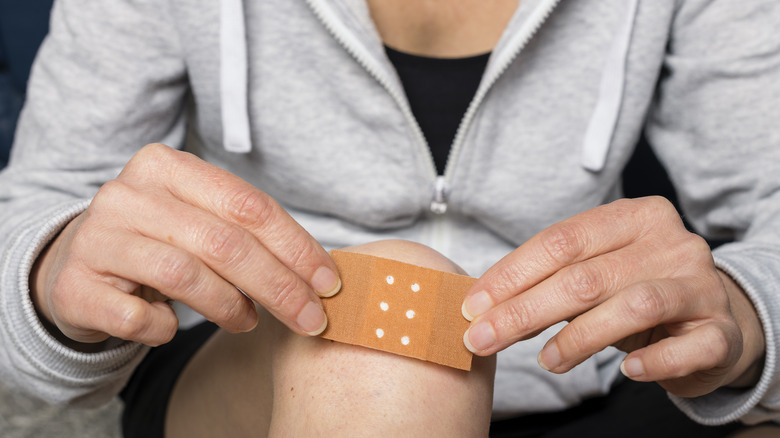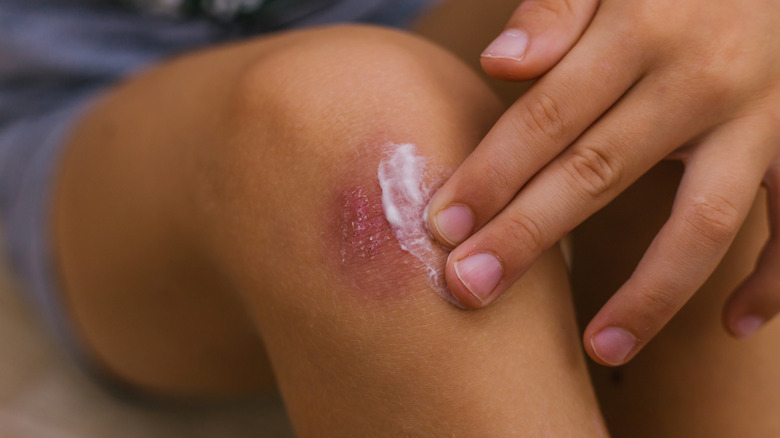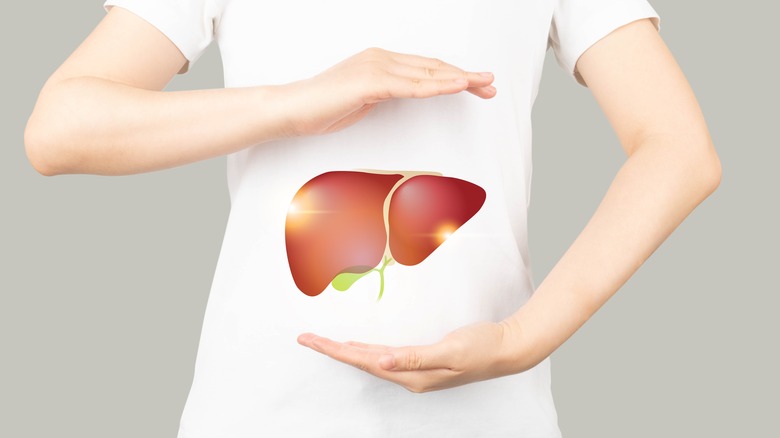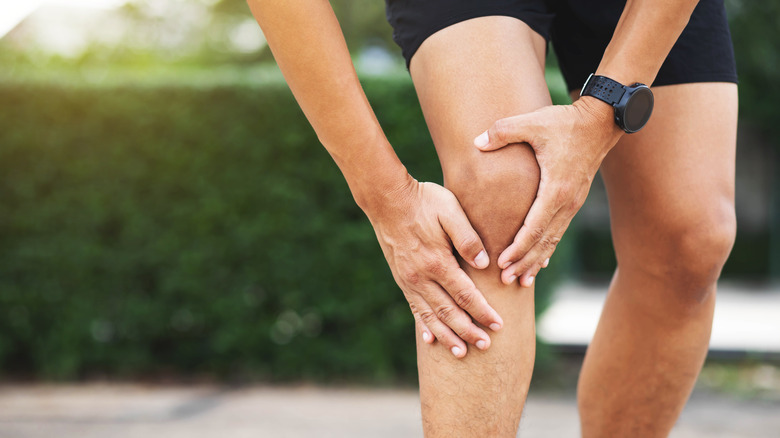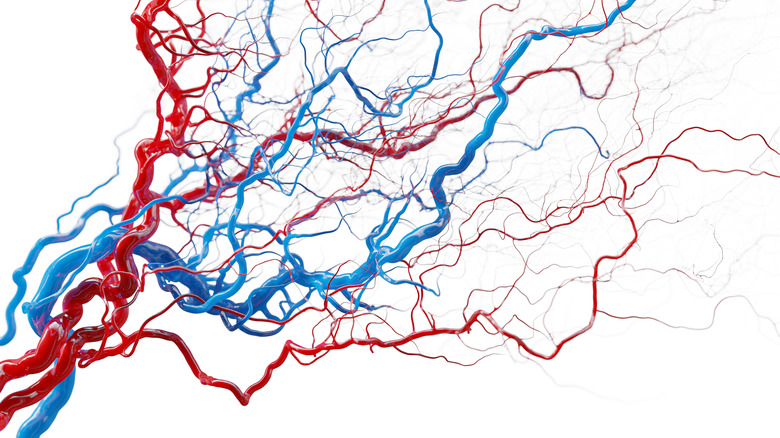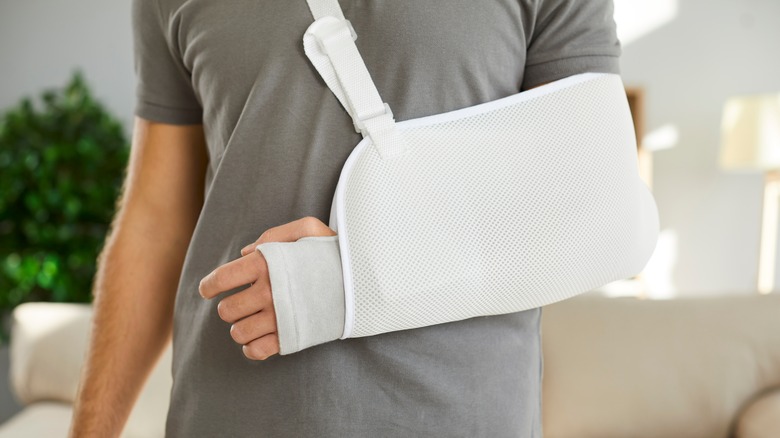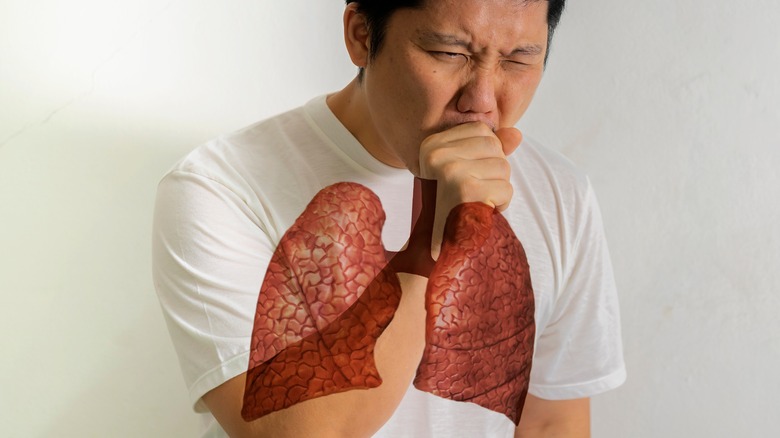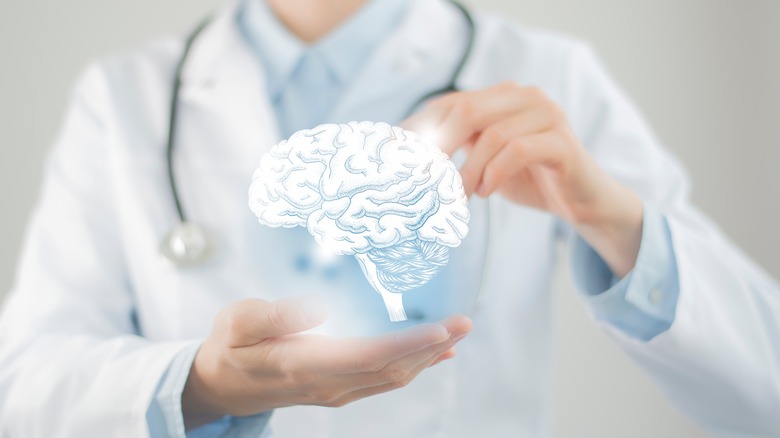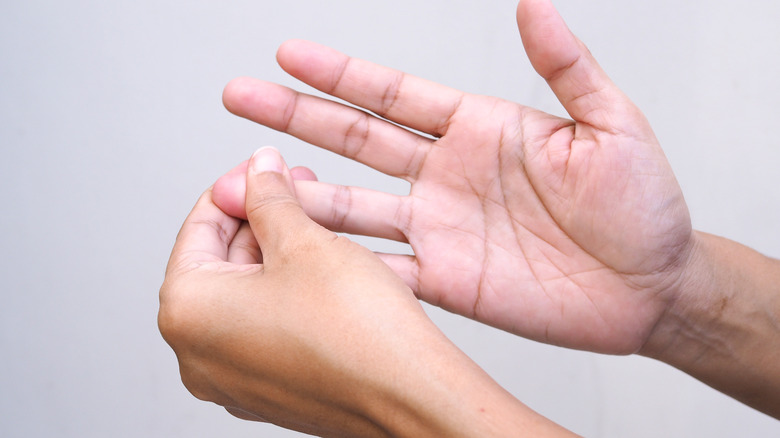9 Parts Of The Body That Can Heal On Their Own
Humans have limited regenerative abilities, unlike hydras, salamanders, and newts (via a review in Stem Cells International). But if we are incapable of matching these organisms' impressive regeneration feats, then how do we heal?
In the process of healing most wounds, the body forms scar tissue. This is known as fibrosis — basically, the body patching up the injured site. As a review published in Transfusion explains, healing is a spectrum, with excess fibrosis on one end and regeneration on the other. Scar tissues are good in the sense that they seal up the injury, but they don't allow healed tissues to function as well as they once did. Fibrosis in internal organs can even lead to organ failure if injuries are repeated or severe.
However, there are some areas of the human body that can repair themselves with minimal scarring. From the liver to the fingertips, here are some body parts capable of healing on their own.
Skin
Regardless of years and years of cuts, scrapes, bruises, scratches, and tears, your skin still mends itself and carries on with protecting and covering internal structures.
Along with the skin, structures such as blood vessels, nerves, and supporting tissues are also repaired after injury (via University of Florida Health). This helps the skin to recover and carry out its previous functions. But in some cases such as severe burns, the skin may not heal properly, and may not attain its previous level of functioning. Each skin injury takes some time to heal, and looks different after healing. This depends on the kind and extent of the injury, as well as the area of the skin that was damaged.
The skin is also able to regenerate by shedding old skin and revealing fresh skin (via Healthline). It's why scars fade naturally with time. This skin turnover is faster when you're younger, but slows down as you age. You can boost your skin's regenerative process by using good skin care products, exercising, having a healthy diet, drinking lots of water, reducing stress, and protecting your skin from sun damage, irritants, and dry weather.
Liver
The liver is a very important and versatile organ. It aids digestion, forms proteins, stores nutrients, supports immunity, and removes toxins and waste, among other functions. Hence, any damage to the liver can seriously impact your health. Fortunately, the liver has the ability to regenerate after injury in order to maintain its size and function.
Regeneration in the liver is possible because a large number of liver cells, called hepatocytes, are in a quiescent (dormant) state (via a review in the International Journal of Molecular Sciences). These cells are activated when there is liver damage, and begin to multiply until the liver reaches its previous size.
Liver regeneration is a well-orchestrated process guided by the immune system. This ability is so remarkable that if a part of the liver is removed (e.g., for organ donation), the liver can grow it back. Removing parts of the liver is not the only way the liver can get harmed, though. Liver damage could come from excessive alcohol consumption, infections (hepatitis A, B, C, or autoimmune hepatitis), certain medications or supplements, or fat accumulation (via Health Match). Liver regeneration may not be able to fix severe or repeated damage. Thus, the liver forms scar tissue, which is called liver fibrosis. Severe liver fibrosis progresses to liver cirrhosis, and may require a liver transplant to treat.
Muscles
The importance of your muscles doesn't need to be stressed. Without well-functioning muscles, you won't be able to move voluntarily. Your muscles help you lift, walk, dance, and perform the finely coordinated movements needed to type.
Your muscles make up about 40% of your body weight, and are composed of strands known as myofibers (via a review in the Journal of Experimental Orthopaedics). Damage to muscles could come from strains, lacerations, contusions, or medical conditions like muscular dystrophy. In response to injury, the body can activate the repair and regrowth of damaged muscles.
For muscles to heal, the injured muscle gets degenerated. This normally triggers a series of immune responses. Ultimately, new, mature, and functional myofibers are formed from muscle stem cells known as satellite cells. Generally, stem cells are non-specialized cells that grow into specific cells with appropriate stimulation. Additionally, supporting structures like connective tissues, blood vessels, and nerves also regrow into the healed muscle to enable it to carry out its functions.
Damage to muscles can range from minor to severe. However, healing after muscle injuries is not always a hundred percent. Minor injuries often heal completely and spontaneously, but severe injuries may heal incompletely if there is fibrosis. Excessive scar tissue affects the function of the muscle after healing. To help, there are therapies that reduce fibrosis after severe muscle injury such as antifibrotic therapy, massage, or physical therapy.
Blood vessels
Blood carries nutrients and oxygen to every tissue in the body while removing waste products, and blood is carried all around the body by blood vessels. As you grow, new blood vessels are continuously being formed, depending on the needs of your body tissues. The process by which new blood vessels are formed is known as angiogenesis (via Angiogenesis).
Angiogenesis also occurs during wound healing; it's an important part of any form of wound healing, whether in the liver, skin, muscles, bones, or gut. For any injury to be completely healed, blood vessels need to grow into the healing tissue and supply it with sufficient blood.
Angiogenesis during wound healing is an organized process, involving chemical signals from cells of your immune system which stimulate blood vessel regrowth when injuries heal. As an injury heals, the bulk of new blood vessels may initially be more than what the tissue needs, but excess blood vessels disappear once healing is complete (via a review in Current Opinion in Rheumatology).
Bones
Although bones seem like sturdy structures, they can get injured and, fortunately, heal after an injury. Bones can get bruised or fractured (broken), depending on the force, location, and type of the injury. While bone fractures take longer than bruises to heal, most bone injuries are capable of healing. However, bone injuries may need splints, casts, slings, braces, or surgical procedures to heal properly (via Cleveland Clinic).
Already, your bone cells have the ability to renew themselves; this happens continuously even when you're in good health, with new bone cells replacing old ones (via Medical News Today). The ability to form new bone cells spearheads bone healing. During the process of bone healing, blood clots form around the site of a broken bone, and the immune system activates inflammation at the injury site. This activates a myriad of processes that ultimately leads to the repair of bones. In some cases, fractures fail to heal properly or completely, and may require surgical intervention to treat.
Gut
Your gut is essentially a long digestive tube that extends from your mouth to your butt, encompassing your stomach and intestines. Since the gut is inside the body, it's easy to assume that it can't get injured. But injury to the gut could come after taking nonsteroidal anti-inflammatory drugs (NSAIDs) like ibuprofen, diclofenac, and aspirin, or other drugs like corticosteroids, bisphosphonates, potassium chloride, steroids, and fluorouracil (via a review in the World Journal of Gastroenterology). Also capable of injuring your gut are stomach acid, the digestive enzyme pepsin, and Helicobacter pylori, bacteria found in the gut.
Your gut survives such injuries because it is lined with a protective tissue called the mucosa. It is the mucosa that suffers the brunt from destructive agents. The mucosa protects the gut by forming a barrier between the contents of your gut and underlying structures, secreting immune agents and substances that neutralize acid and pepsin.
The gut can get injured when the mucosa is overwhelmed by destructive agents (e.g., when acid or pepsin is produced excessively, prolonged use of NSAIDs). Gut injuries are associated with diseases like gastritis, duodenitis, peptic ulcer disease, or gastroesophageal reflux disease (GERD). Still, the gut heals itself under the influence of the immune system. Gut healing could take months, depending on the nature and extent of the injury as well as whether the destructive agent is still present. There are also treatments that aid gut healing.
Lungs
When you breathe, you take in oxygen from the air and expel carbon dioxide from your body through your lungs. But as you breathe, your lungs are exposed to infectious microbes, pollutants and irritants, because air isn't exactly sterile.
The lungs have a protective mucosal barrier and a robust immune response to airway infections. Apart from these protective measures, your lungs and the rest of your respiratory tract are capable of self-healing after damage. But with repeated and extensive injuries (like from chronic inflammation, chronic lung diseases, or long-term smoking), lung healing may result in fibrosis (via a review in Clinical & Translational Immunology).
Previously, the lungs were thought to be incapable of regeneration; it was assumed that fibrosis happened in response to any form of lung damage (via a review in Nature Medicine). However, the lungs and other parts of the respiratory tract are capable of some level of regeneration. Just like the liver, regeneration in the lungs is possible because the lungs have quiescent cells which serve as stem cells. When there is lung damage, these cells develop into specialized lung cells to replace damaged cells. Scar tissues are only formed when lung regeneration is not able to repair the injury, or when the ability of the lungs to regenerate is limited. When there is lung fibrosis, your ability to breathe is affected because fibrosis makes the lungs less elastic.
Nerves and the brain
The way nerves heal and regenerate depend on the type and intensity of the injury (via a review in the International Journal of Molecular Sciences). Nerves regenerate by regrowing and traveling to meet the previously supplied tissue. Nerve regeneration is not always perfect, though. There could be problems when the newly formed nerve doesn't find the right tissue, or doesn't grow long enough to meet any target.
Although nerves in your brain don't have the ability to regrow after injuries (like stroke or traumatic brain injuries), your brain can recover its function through a process known as neuroplasticity (via StatPearls). This is basically the rewiring of the brain following an injury so that the functions that were once performed by the damaged area can be performed by another area. The brain is constantly rewiring and changing, and this depends on the stimulus it receives (like learning something new, for example).
Neuroplasticity following brain damage can be influenced by factors like exercise, the environment, repetition of tasks, motivation, and drugs. The challenge in medicine is to guide neuroplasticity after injury by administering the right interventions within the right windows in order to restore function after brain damage.
Fingertips
You use your hands to touch, hold, and operate things, gesture, and other important activities. Any damage to your hands (especially your fingers) can be devastating.
One fascinating capability of your fingertips and toe tips is regeneration following injury or amputation. This is possible even among adults, as evidenced in a study published in the International Journal of Molecular Sciences. The researchers also found that regenerated fingertips were comparable in appearance and function to fingertips on an uninjured hand.
The fingertips and toe tips are the only parts of your limbs that are capable of regenerating (via a review in Stem Cells International). The tips of your fingers and toes have not just skin, but also fat, muscles, nerves, blood vessels, tendons, bones, and nails; these structures can be regenerated. However, to restore the fingertip structures to their preinjury status in terms of appearance and function, you may need wound care from a specialist. As for other parts of the finger, It's possible for them to be surgically reattached or replanted after amputations. The replanted finger may only be able to carry out some of its previous functions, though.

